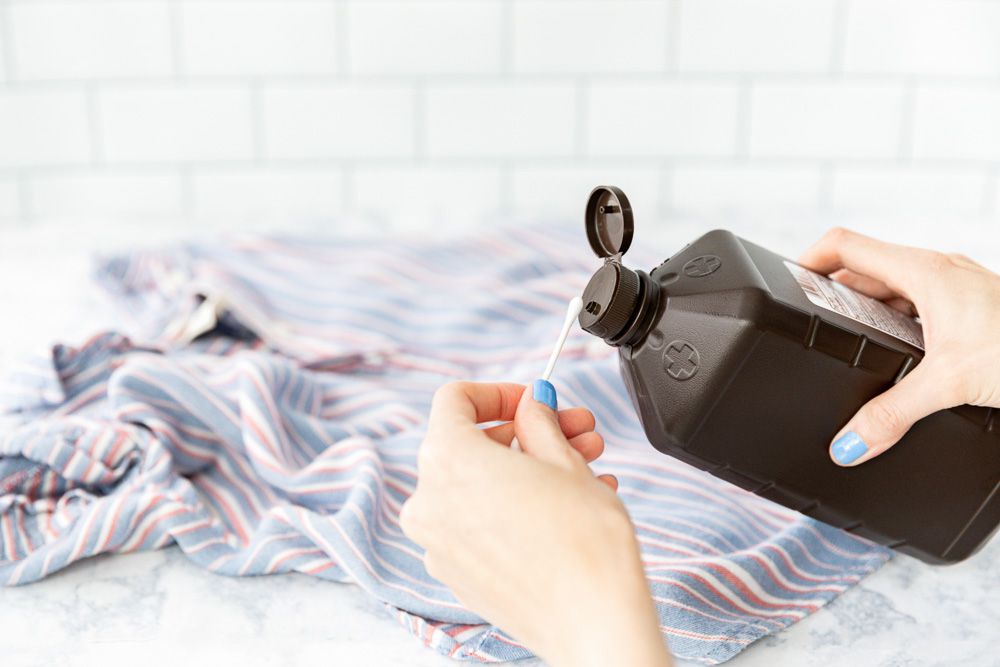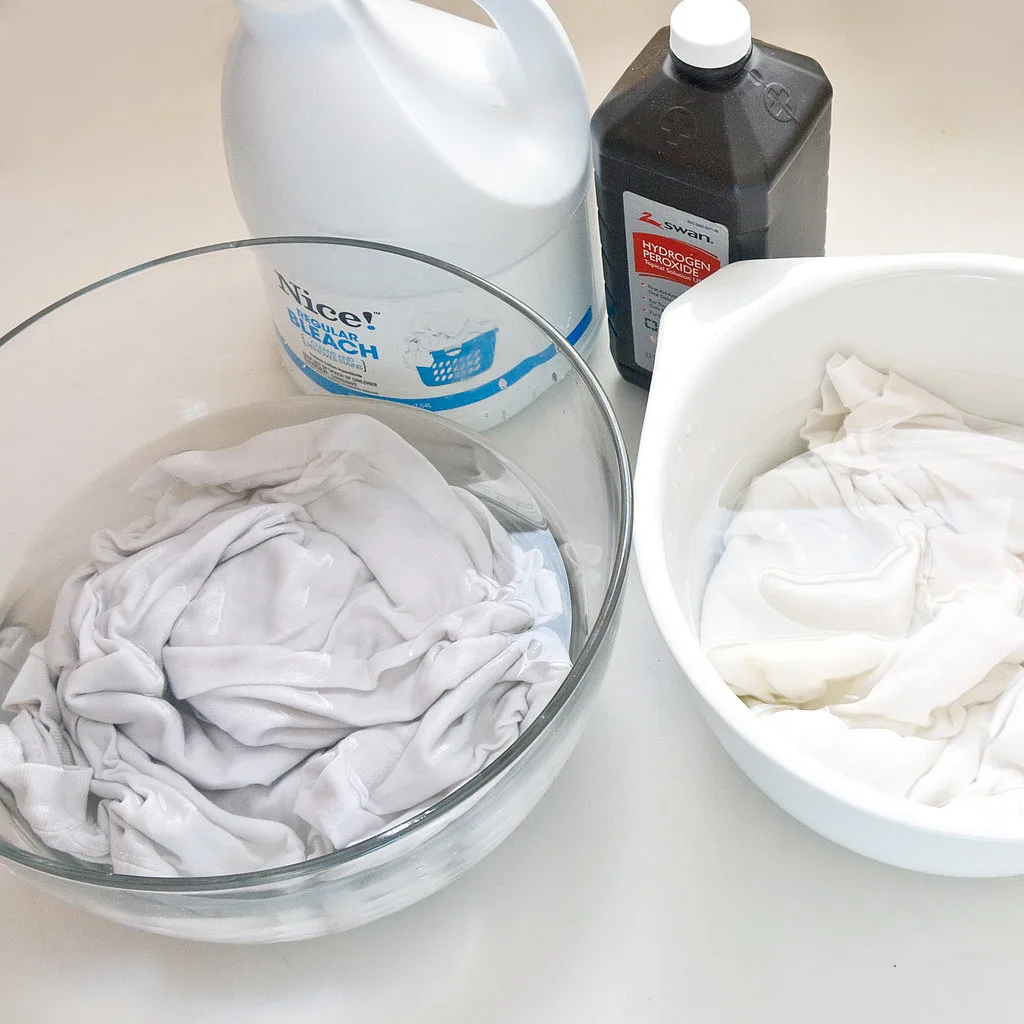Hydrogen peroxide is a versatile and useful substance that can be found in most households. It is often used as a disinfectant, a cleaning agent, and a bleaching agent. However, many people are unsure about whether hydrogen peroxide can stain clothes. In this blog post, we will explore the properties of hydrogen peroxide and whether it can cause stains on clothes.
Hydrogen peroxide is a chemical compound that contains two atoms of hydrogen and two atoms of oxygen. It is a clear liquid that is slightly more viscous than water. When it comes into contact with organic material, such as bacteria or stains on clothes, it breaks down into water and oxygen. This means that it is a safe and environmentally friendly bleaching agent, as it does not release harmful chemicals into the environment.
When it comes to usng hydrogen peroxide on clothes, it is generally safe to use on all washable, dye-stable fabrics. This means that it is suitable for use on most types of clothing, including cotton, polyester, and wool. However, it is important to note that hydrogen peroxide may not be effective on all types of stains. For example, it may not be effective on oil-based stains, such as grease or cooking oil.
To use hydrogen peroxide on clothes, simply pour some Hydrogen Peroxide 3% – Oxygen PlusTM on a clean cloth or paper towel and gently dab the stained area. Let it sit for 20 minutes before washing the item as usual in your washing machine. It is recommended to wash the stained item with cold water and normally used soap or detergent. Alternatively, you can soak the entire garment in a bowl of hydrogen peroxide for 15 to 20 minutes. After soaking, remove the stained clothing from the hydrogen peroxide and rinse it out in cold water.
It is important to note that hydrogen peroxide may cause some discoloration or fading on clothes if it is not used properly. To avoid this, it is recommended to test a small, inconspicuous area of the garment before using hydrogen peroxide on the entire item. This will help you to determine whether the fabric is dye-stable and whether the hydrogen peroxide will cause any discoloration or fading.
Hydrogen peroxide is a safe and effective bleaching agent that can be used on most types of clothes. It is environmentally friendly and breaks down into water and oxygen, making it a more sustainable option than chlorine bleach. However, it is important to use hydrogen peroxide properly and to test a small area of the garment before using it on the entire item. With these precautions in mind, hydrogen peroxide can be a useful tool for removing stains and keeping your clothes looking their best.
Is It Safe to Use Hydrogen Peroxide on Clothes?
Hydrogen peroxide is safe to use on clothes that are washable and dye-stable. It is a type of oxygen-based bleach that is commonly used as a stain remover and whitening agent. Hydrogen peroxide breaks down into water and oxygen, making it a more eco-friendly bleach option than chlorine bleach (sodium hypochlorite). However, it is important to always follow the instructions on the label and test a small, inconspicuous area of the fabric before using it on the entire garment to ensure that it does not cause any damage or discoloration. hydrogen peroxide is a great option for keeping your clothes loking clean and bright.

Removing Hydrogen Peroxide Stains from Clothes
Hydrogen peroxide is a powerful cleaning agent that is commonly used to remove stains from clothes. However, if it is not used properly, it can leave unsightly stains on your clothes. If you have accidentally spilled hydrogen peroxide on your clothes and are wondering how to remove the stains, here is a step-by-step guide to help you out.
Step 1: Act fast
The first and most important step is to act fast. As soon as you notice the hydrogen peroxide stain on your clothes, you should try to remove it as quickly as possible. The longer the stain sits on your clothes, the harder it will be to remove.
Step 2: Blot the stain
Take a clean cloth or paper towel and gently blot the stained area. Make sure not to rub the stain, as this can spread it futher and make it harder to remove.
Step 3: Apply hydrogen peroxide
Pour some Hydrogen Peroxide 3% – Oxygen PlusTM on a clean cloth or paper towel and gently dab the stained area. Make sure to cover the entire stain with the hydrogen peroxide.
Step 4: Let it sit
Let the hydrogen peroxide sit on the stain for at least 20 minutes. This will give it enough time to break down the stain and make it easier to remove.
Step 5: Wash the item
Wash the item as usual in your washing machine. Make sure to use a good quality laundry detergent and set the water temperature to the recommended level for the fabric. If the stain is still visible after washing, repeat the process again until it is completely gone.
Removing hydrogen peroxide stains from clothes is a simple process that can be done with a few simple steps. By acting fast and using the right technique, you can quickly and easily get rid of these unsightly stains and restore your clothes to their original condition.
How Long Should Hydrogen Peroxide Remain on Clothes?
Hydrogen peroxide is a common household item that is oftn used to remove stains from clothes. When using hydrogen peroxide on clothes, it is important to follow the instructions carefully to avoid damaging the fabric. In general, you should leave the hydrogen peroxide on the clothes for no more than 15 to 20 minutes. After this time, you should rinse the clothes thoroughly with cold water to remove any residue. Leaving hydrogen peroxide on clothes for too long can cause the fabric to become discolored or weakened, so it is important to be careful when using this product. Additionally, it is a good idea to test a small, inconspicuous area of the fabric before using hydrogen peroxide on the entire garment to ensure that it does not cause any damage.
The Effects of Hydrogen Peroxide on Clothing
Hydrogen peroxide is generally considered safe for clothes, but there are some factors to consider. While it can effectively remove stains and brighten whites, it is important to note that hydrogen peroxide can cause discoloration or stains on cetain fabrics. Synthetic fibers such as polyester, nylon, and spandex are known to react poorly with hydrogen peroxide and may result in a yellow or brown tint.
Additionally, prolonged exposure to hydrogen peroxide can weaken the fibers of certain fabrics, causing them to become brittle or even disintegrate over time. It is important to follow the instructions on the label of any hydrogen peroxide-based cleaning products and not to leave them on fabric for longer than recommended.
To minimize the risk of discoloration or damage, it is recommended to test a small, inconspicuous area of the fabric before applying hydrogen peroxide to the entire garment. This will allow you to determine whether the fabric is compatible with hydrogen peroxide and avoid any potential damage. Overall, while hydrogen peroxide can be a useful tool for removing stains from clothes, it is important to use it cautiously and with care to avoid any unwanted discoloration or damage.
What Items Should Not Be Cleaned With Hydrogen Peroxide?
Hydrogen peroxide is a versatile and effective cleaner and disinfectant that can be used for a variety of purposes. However, there are certain things that you should avoid cleaning with hydrogen peroxide. First and foremost, you should never use hydrogen peroxide on wounds. Contrary to popular belief, hydrogen peroxide can actually damage healthy tissue and slow down the healing process. Instead, clean wounds with soap and water and seek medical attention if necessary.
Another thing to avoid cleaning with hydrogen peroxide is acne-prone skin. While it may seem like a good idea to use hydrogen peroxide to kill bacteria and reduce inflammation, it can actually irritate the skin and make acne worse. Instead, stick to gentle cleansers and acne treatments recommended by your dermatologist.
In addition to wounds and acne, you should also avoid using hydrogen peroxide on certain types of surfaces and materials, such as natural stone, marble, and colored fabrics. Hydrogen peroxide can bleach or discolor these materials, so it’s best to use a different cleaner that is safe for these surfaces.
Hydrogen peroxide is a powerful cleaning and disinfecting agent, but it’s important to use it safely and appropriately. By avoiding certain things like wounds, acne-prone skin, and certain materials, you can ensure that you get the most out of this versatile cleaning solution.

Does Hydrogen Peroxide Cause Yellowing of Clothes?
Hydrogen peroxide is a powerful oxidizing agent that is commonly used as a bleach or stain remover for clothes. However, prolonged or excessive use of hydrogen peroxide on clothes can cause them to turn yellow. This is due to the chemical reaction that occurs when the peroxide cmes into contact with the natural fibers in the fabric, which can damage the fibers and cause discoloration. The yellowing effect is more pronounced on light-colored clothes such as white or pastel shades. To prevent this from happening, it is important to follow the instructions on the label of the hydrogen peroxide product and not to overuse it. If you notice yellow stains on your clothes after using hydrogen peroxide, you can try soaking them in a solution of equal parts vinegar and water for about 30 minutes before washing them as usual. The acidic properties of the vinegar can help to neutralize the peroxide and remove the yellow stains, leaving your clothes looking fresh and clean again.
Leaving Hydrogen Peroxide on Clothes Overnight
You can leave hydrogen peroxide on clothes overnight to remove stains. Hydrogen peroxide is a mild bleaching agent and can help to break down and remove tough stains from clothing fibers. To use hydrogen peroxide, simply apply it directly to the stain, making sure to saturate the affected area. Let the hydrogen peroxide sit on the stain overnight, allowing it time to work its magic.
It is important to note that hydrogen peroxide can potentially bleach or fade colored fabrics, so it is best to test it on an inconspicuous area first before applying it to a larger stain. Additionally, it is alays a good idea to follow up with a regular wash cycle to fully remove any remaining hydrogen peroxide and to prevent any potential damage to your clothes. leaving hydrogen peroxide on clothes overnight can be an effective way to remove tough stains, but it is important to use it carefully and with caution.
Conclusion
Hydrogen peroxide is a versatile and effective cleaning agent that can be used for a variety of purposes. It is a safe and environmentally friendly alternative to chlorine bleach, making it a popular choice for households and businesses alike. Its ability to break down safely into water and oxygen makes it a preferred choice for individuals who are concerned about the impact of harsh chemicals on the environment. Whether you need to remove stains from clothing, clean surfaces or disinfect wounds, hydrogen peroxide is a reliable and effective solution. However, it is important to note that hydrogen peroxide should not be used on delicate fabrics or surfaces and should be used with caution around eyes and other sensitive areas. hydrogen peroxide is a valuable addition to any cleaning or fist aid kit, providing a safe and effective solution for a wide range of cleaning and disinfecting needs.
